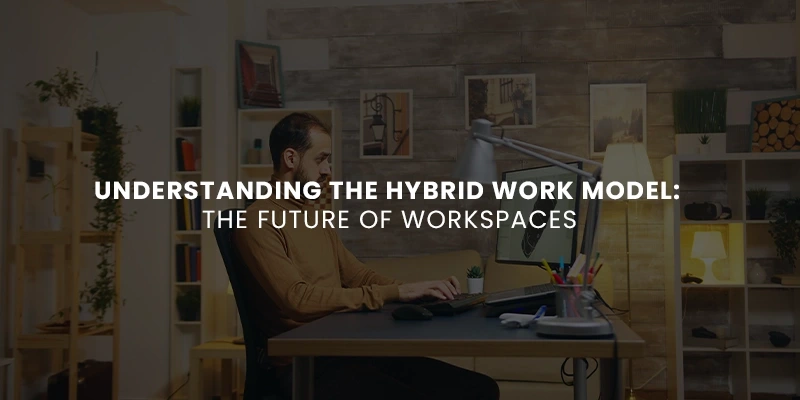Understanding the Hybrid Work Model: The Future of Workspaces
In the last few years, the corporate landscape has changed dramatically. The rigid 9-to-5 office setup is no longer the standard for many organizations. Instead, companies are increasingly embracing flexible workspaces and hybrid arrangements that combine the best of remote work and in-office collaboration. This evolving trend is known as the hybrid work model, and it has redefined how professionals view productivity, collaboration, and workplace culture.
In this blog, we’ll explore what the hybrid work model really means, its different structures, the factors driving its growth, and how hybrid office solutions such as virtual offices and flexible workspaces can support this new way of working.
What is the Hybrid Work Model?
The hybrid work model is a working arrangement that allows employees to divide their time between remote work and on-site office work. Instead of being tied to a fixed location, professionals can choose when to work from home, a coworking space, or the company’s physical office.
This balance enables employees to enjoy the convenience of remote work while still benefiting from in-person interactions that drive collaboration, team culture, and innovation. For companies, it means access to a wider talent pool and the ability to design cost-effective workspace strategies.
Types of Hybrid Work Models
The structure of a hybrid work setup often depends on the company’s goals, team size, and industry. Here are some common variations:
1. Flexible Hybrid Model
Employees decide when and where they work. This gives maximum freedom but requires strong coordination tools to ensure efficiency.
2. Fixed-Day Hybrid Model
Organizations designate specific days for in-office work. For example, employees may work remotely on Mondays and Fridays while spending Tuesdays to Thursdays at the office.
3. Role-Based Hybrid Model
Some roles demand in-person presence (such as client-facing teams), while others (like digital marketing or IT) can function remotely most of the time.
4. Office-First Hybrid Model
Employees are expected to come to the office regularly, but remote work is allowed occasionally when required.
Why is the Hybrid Work Model Rising?
Several factors are pushing businesses worldwide to adopt the hybrid mode of working:
- Technological advancements: Cloud platforms, video conferencing, and project management tools have made remote collaboration seamless.
- Changing workforce expectations: Professionals today prioritize flexibility, work-life balance, and location independence.
- Post-pandemic workplace shift: The global lockdown proved that remote work is possible without compromising productivity, encouraging companies to rethink their real estate needs.
- Cost efficiency: Companies save significantly on overheads like utilities, large office rentals, and maintenance.
Benefits of the Hybrid Work Model
For Employees:
- Better work-life balance: More time for personal commitments and reduced commute stress.
- Flexibility: The option to work in an environment that suits their productivity, whether at home or in a flexible office space.
- Improved morale: Empowerment to choose working styles leads to greater job satisfaction.
For Employers:
- Enhanced productivity: Studies suggest employees are more focused when given flexibility.
- Talent acquisition: Companies can attract professionals beyond geographical boundaries.
- Reduced costs: Hybrid models minimize the need for large permanent office setups.
Challenges of the Hybrid Model
Despite the popularity of the hybrid system, it also has its shortcomings:
- Open communication: Access to good digital tools to ensure effective collaboration between employees in different geographical locations.
- Employee engagement: Some employees tend to lose touch when they are not physically present in an office environment.
- Implementation of Policies: Provision of clarity on schedules, performance, and accountability, among others, is critical.
How Flexible Workspaces Support Hybrid Models
This is where The Office Address plays a key role. Hybrid teams often need more than just a traditional office—they require flexible workspace solutions that adapt to their working style.
- Virtual offices provide a professional business address, mail handling, and call services while employees work remotely.
- Coworking and flexible office spaces allow remote staff to access a professional environment when home isn’t ideal for productivity.
When choosing a workspace for hybrid teams, businesses often need to decide between shared spaces and private offices. Each option has its benefits—shared spaces offer flexibility and cost-efficiency, while private offices provide dedicated space and privacy. Understanding these options helps businesses select a setup that aligns with their team’s working style.
- Scalable office solutions mean companies only pay for the space they need, helping them manage costs efficiently.
- Community and networking opportunities in flexible workspaces allow remote professionals to stay connected with like-minded peers.
By leveraging hybrid office solutions, organizations can create a supportive, cost-effective, and dynamic work culture.
Conclusion
The hybrid work model is no longer just a trend—it’s the future of work. By blending the convenience of remote working with the collaborative power of physical office spaces, it allows businesses to stay competitive while giving employees the freedom they value.
As companies continue to rethink their workplace strategies, solutions like flexible offices and virtual office addresses will play a pivotal role. At The Office Address, we specialize in providing tailored workspace solutions that align with the hybrid era, helping businesses thrive in a world where flexibility, productivity, and innovation go hand in hand.
